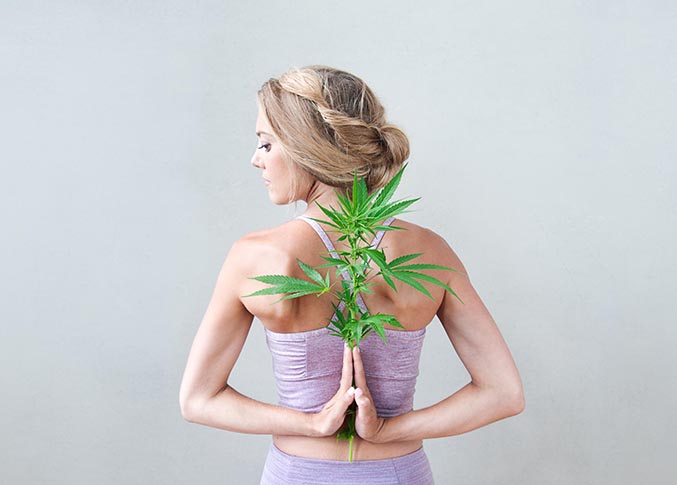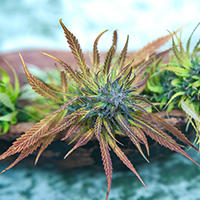Rachael Carlevale, founder of Ganjasana, with cannabis plant. Photo by Tracey Eller (ellerimages.com), courtesy @CosmicSister
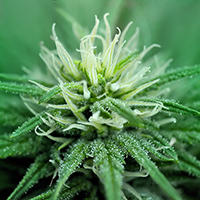 “Cannabis is an ambassador plant that is bridging worlds and opening conversation about how we co-evolved with sacred plants and how they are natural evolutionary allies for exploring and expanding consciousness.” - Zoe Helene, LA Yoga
“Cannabis is an ambassador plant that is bridging worlds and opening conversation about how we co-evolved with sacred plants and how they are natural evolutionary allies for exploring and expanding consciousness.” - Zoe Helene, LA YogaTwenty people sit in sukasana, breathing together, on a flower of mats on the floor of a Boulder, Colorado studio. Like the flower’s pistil, at the center of the circle, is a candlelit altar of cannabis plants in living, organic soil, among other earthly delights: worms, vermicompost, sit beside healing stones and mapacho, tobacco plants sacred to the indigenous peoples of the Amazon. The group is gathered at the Earth Yoga studio for a cannabis-focused yoga ceremony called Ganjasana.
All 40 eyelids fall shut, and the group enters into a guided meditation designed to “drop people into the present moment, and shift our nervous systems into the parasympathetic state—the rest and digest state, where connection to plant spirit it possible,” says teacher Rachael Carlevale, founder of the Ganjasana yoga system.
After they set their intentions for working with “the plant medicine,” the yogis are immersed in permaculture education designed to get to the source of the cannabis plant—the soil. Worms move through their fingers as they react into the compost at the center of the circle.
“Feeling the worms move through our fingers allowed us to deeply connect with the life source of our ganja plant medicine,” Carlevale says.
Pranayama’s next, then the group collectively partakes in collective, conscious consumption of the cannabis plant.
“We are quiet, no talking when consuming; it is a sacred time to turn inward and quiet the mind,” Carlevale says. “Our ceremonies are designed to model nature, to align with her natural rhythms, to connect with cannabis plant spirit medicine.”
As more and more yoga teachers and studios across the United States and wordwide pair the practice with the cannabis plant today, they’re actually participating in a reunion, not a passing fad.
The use of this plant in tandem with yoga is nothing new. Cannabis has been revered as sacred in India for millennia, and it forms the roots of yogic history. The links between the two are ancient.
At first glance, cannabis and yoga might sound to many like an odd couple, unlikely to last. Yoga emphasizes pure mind and body, and cannabis comes with a contentious “high” and political question marks. Yet the two share very old roots. Evidence suggests yogis in India used cannabis millennia ago as they developed hatha, the first yogic movements. Ceremonial consumption of “ganja” has been entwined with yogic tradition from the beginning.
Perhaps guided by this intuitive connection between the herb and the practice, today, women are at the forefront of a small but growing movement to reconnect yoga with the herb responsible, at least in part, for of its very creation.
Ganjasana: Messages from the Cannabis Plant
When Carlevale sits in a circle with her students around a cannabis plant, she asks them to take in the plant’s energy—its color, message, vibe. Over the course of an hour, Carlevale and her students, all of whom have ingested the herb before the class, use yogic movements and breathing to enhance their connection with the messages the cannabis plant has to offer.
Carlevale is a Boulder, Colorado-based yoga teacher and cannabis advocate who, through the feminist cannabis and psychedelics education and advocacy network Cosmic Sister, has worked with plant medicines over several years under the guidance of ayahuasca shamans in the Amazon. Ganjasana pairs yoga with the ancient plant ceremony traditions of the Shipibo indigenous people of the Amazon to tap into the lessons of the cannabis plant.
“The combination of cannabis and yoga has been around for thousands of years,” she says, noting the foundational yogic Hindu texts, The Vedas, trace the use of ganja by sadhus—Indian holy men and yogis who eschew society in pursuit of spirituality—back to ancient times.
She's right.
Lord Shiva, god of yoga and supreme masculine Hindu deity, is said to have a love of ganja that stretches back to the very formation of Hinduism. He is also god of cannabis, and it’s likely no coincidence.
Echoes of Shiva’s many-storied relationship with the plant are visible in statues, tapestries and other depictions around the world. He’s often depicted clutching a cluster of herbs or a slender cone-shaped pipe known as a chillum. In some traditions, Shiva and Shakti are expressed together as one in the androgynous deity Ardhanarishvara, and many stories tell of Ardhanarishvara enjoying cannabis as well.

Cannabis, sage and lavender plant spirit smudge sticks by TreeStuff (etsy.com/shop/treestuff). Photo by Tracey Eller (ellerimages.com), courtesy @CosmicSister
Carlevale credits the combination of cannabis, yoga and ayahuasca—the psychedelic plant brew indigenous to South America’s Amazon basin—with saving her life. After she was diagnosed with cancerous uterine tumor, she opted to use these “plant medicines,” in tandem with a yoga practice she’d been cultivating since she was 15, to heal herself rather than get a hysterectomy.
She initially learned about the potential of plant medicines via Medicine Hunter Chris Kilham, famed ethnobotanist, lifelong yogi and author of the best-selling yoga book The Five Tibetans. Kilham taught a field course in the Peruvian Amazon called the Shaman’s Pharmacy at the University of Massachusetts, where Carlevale was a pre-med student.
Carlevale took Kilham’s class after becoming disenchanted with the pre-med program because of its tendency to address “symptoms with pills” rather than digging for the causes of illness, and it led her to refocus her career on holistic health and yoga.
As part of his class, Kilham brought students to Iquitos, Peru, to learn about native medicinal plants from the region. There, Carlevale met and connected with Zoe Helene, Kilham’s wife and the founder of Cosmic Sister. Helene encourages women to “come out of the cannabis (and psychedelics) closet” via the Cosmic Sister network and public outreach program. She calls it a “psychedelic feminist” mission to help women expand and liberate their consciousness.
“When I commune with cannabis in my yoga practice, I find it helps me open up and drop town into the experience on a different level,” she says. Helene has focused her efforts on connecting women with “sacred plants” because women have been historically less inclined to speak out about and explore cannabis, psychedelics and other mind-altering substances, which she believes can benefit them immensely.
“Cannabis is an ambassador plant that is bridging worlds and opening conversation about how we co-evolved with sacred plants and how they are natural evolutionary allies for exploring and expanding consciousness,” she says.
Carlevale was the first-ever recipient of a merit-based award called the Cosmic Sister Plant Spirit Grant, which brings women doing work in the name of feminism, wilderness, wildlife and psychedelics to the Amazon to experience ayahuasca in a well-vetted, traditional set and setting.
After she participated in ayahuasca ceremonies in Peru, Carlevale began taking high-CBD cannabis concentrates, which have proven to reduce pain, tumors and inflammation. In the months that followed, her tumor shrunk 20 millimeters.
The Shipibo tradition teaches that the plants, which have inhabited this planet much longer than humans, possess ancient wisdom. Our communion with certain plants, in this case cannabis, can impart ancient lessons, Carlevale explains.
Ganjasana offers various ceremonies, including a women’s Green Tent cannabis-yoga circle on the new moon, designed to connect women with “divine feminine energy” and empowerment.
One participant anonymously described these ceremonies as transformational. “I laughed, I cried, I connected with the divine power of the feminine,” she wrote in a testimonial. “Rachael has traveled the world, connected with the earth, and is truly passing down ancient female wisdom and empowerment through this workshop. I personally find it fascinating how the female cycle syncs with the moon phases, and sitting in a circle of women being able to talk about that openly with love and zero judgement was an amazing experience.”
Ancient Roots
Herbalist Brigitte Mars, author of 13 books and professor at Buddhist-based Naropa University in Colorado, has practiced yoga and used cannabis for years. She points out that in many ancient depictions of Shiva, Shiva’s topknot is clearly sprouting a cannabis leaf. That’s important, because Hindus believe that topknot is the source from which the Ganges River flows.
During a cannabis-friendly yoga class in Portland, Oregon, I heard one retelling of a Hindu legend saying cannabis plants sprouted up in places where the devas, or gods, had dripped Amrita, the elixir of life. Shiva stumbled upon one of those plants and was rejuvenated. He grew fond of cannabis.
In The Yoga Sutras (book 4, verse1), written in 400CE, Patanjali wrote, “the subtler attainments come with birth or are attained through herbs, mantra, austerities or concentration.” Cannabis nectar was the Vedic goddess Indra’s favorite drink, according to stories from ancient yogic tantra cults, who influenced the evolution of yoga into the physical postures of hatha. In tantric cults, cannabis has long been revered as a link to the divine, as explained in a July 1977 article in the Journal of Psychedelic Drugs.
Some yogis argue that Patanjali’s mention of herbs didn’t include cannabis, but the Vedas and countless Hindu stories suggest otherwise.
White Lotus Foundation founder Ganja White, whom Yoga Journal called the “architect of American Yoga,” says Patanjali’s Sutra, book 4, verse 1 is more than enough evidence for yogis who want textual reference and approval before combining cannabis with yoga. Patanjali says awakening can come naturally or congenitally, from meditation, suffering, inner flame, or herbs and elixirs. Whether it’s an ally, medicine, or poison is relative to the individual.
“Certainty is what we want,” White says, “but relativity is what we have.”
White also notes the long tradition of yogis using “temple hash” in India and Nepal.
“We seem to have a symbiotic relationship with these alkaloids, and our bodies are loaded with cannabinoid receptors,” he says. He’s referring to the endocannabinoid system, a group of neuromodulatory lipids and receptors in the human brain that regulate many physiological processes like pain, mood, appetite, memory and more. The scientific reason cannabis can help with such a wide range of symptoms is the way it interacts directly with the brain’s endocannabinoid system via its chemical compounds, cannabinoids.
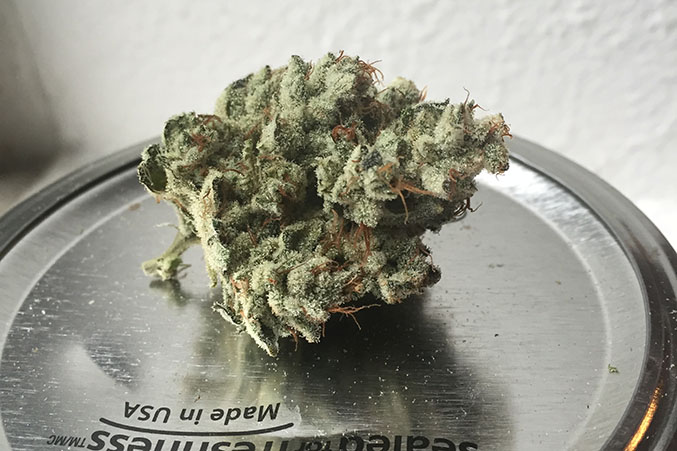
Regenerative cannabis bud grown with living soil. Photo courtesy Ganjasana (@Ganjasana)
Cannabis as Harm-Reduction Medicine
As cannabis is gradually re-legalized in the U.S. and elsewhere, the public is learning about its potential to help children with epilepsy, shrink cancerous tumors, alleviate chronic pain (more safely and successfully than opiates, helping to combat the national overdose epidemic), and provide feelings of relaxation and bliss in a much safer way than alcohol.
Selma Holden, an M.D. in Maine who recommends cannabis to medical patients according to the state’s laws, is also a yoga teacher who focused on yoga at Harvard's Integrated Wellness special program. She practices family medicine in rural Maine and became interested in cannabis medicine as a response to Maine’s opiate overdose epidemic. She says the way cannabis manages pain is, in itself, yogic.
In rural areas where people tax their bodies, whether by logging in the woods or catching lobster on the shore, there was a chronic pill problem, she says. Holden calls herself the “newer breed of doctors” whose training included warnings against overprescribing opiates for pain, but she could see her patients needed a solution. When a friend told her about cannabis as medicine, she saw it as “a harm-reduction method, quite frankly, to get people to step off of opiates.”
Unlike opiates, which she says can be considered a “painkiller” that erases pain, she says, cannabis changes people’s reaction to the pain.
“You can be more contemplative about it, you don’t experience the suffering of it so much, you’re just more in this yogic awareness, or mindful awareness, of noticing the pain, analyzing it, not reacting to the pain instantaneously, but maybe working with it,” she says.
Sometimes Holden recommends both yoga and cannabis to her clinical patients.
“I wish everybody would be able to have the time and space to explore these disciplines, and establish one, and weave it into their life,” she said. “There’s so much destruction and so much anger in this world right now, and I am feeling impatient about getting these medicines available to people because we need to move more quickly on healing from the traumas and damages that are happening to the world.”

Rachael Carlevale wearing a cannabis, sage and lavender plant spirit floral crown by Julia Moore (@laughingmoonflowers). Photo by Tracey Eller (ellerimages.com), courtesy @CosmicSister
Women, Yoga and the Cannabis Closet
Cannabis is the fastest-growing industry in the United States, and talking openly about using it no longer holds the shock value it once did. As more and more regions legalize and recognize cannabis for its potential to heal, relax and provide a “high” that’s been proven to be much safer than alcohol, more and more people are coming out of the cannabis closet. Still, certain sub-groups cling to remnant taboos of the Reefer Madness panic.
Women are historically less apt than men to speak out about their cannabis use, often for fear of judgment and persecution. Organizations like Cosmic Sister and the nonprofit Women’s Visionary Congress have set out to address this disparity and help women become more forthright about their experiences with altered states of consciousness.
The yoga world is another sector where cannabis use remains mostly in the closet—but that doesn’t mean yogis aren’t using it. In the process of researching this article, and being a yoga teacher myself, I've spoken (off the record) with more than one world-renowned yoga teacher who enjoys cannabis—sometimes in tandem with personal practice—but keeps it hush-hush for fear of being judged as less wholesome and scaring off students.
It’s an interesting twist of fate that the yoga teachers working vocally to reunite the herb with the practice are almost all women.
Mars says cannabis has innate connections with women, and she sees cannabis rising in parallel with women across the world.
“Cannabis causes people to think for themselves,” she says. “Cannabis is a feminine plant. ... It’s a plant that bears male and female plants. When you think about the nature of femininity, it’s about nourishing and treating and cultivating.”
Helene, an accomplished artist who practices yoga daily, is a vocal cannabis cultural activist who encourages women in particular to “come out of the cannabis (and psychedelics) closet” via the Cosmic Sister network and public outreach. Her personal relationship with cannabis began by accident when she was a performing arts student in the 1980s. She’d bought into the propaganda and was “terrified” to try it for fear of jeopardizing her college scholarship. Then one night, on the way to a party, she gave it a shot. She never made it to the party. Instead, she lay down on a bed and meditated. A professional belly dancer, she was already in tune with mind-body-spirit trance modalities, but now she zeroed in on it in a way that was “entirely new.” She experienced a “blissful rainbow of colored energy” moving up and down an “intricate, exquisitely designed integrated intranet” inside her body. That sounds suspiciously similar to an experience of the yogic chakras.
Now, she says, “when I incorporate cannabis into my yoga practice, I find it helps me really open into the experience. I see cannabis as an ambassador plant because it is bridging worlds and opening conversation about how we co-evolved with plants and how they are our natural allies for exploring and expanding consciousness.”
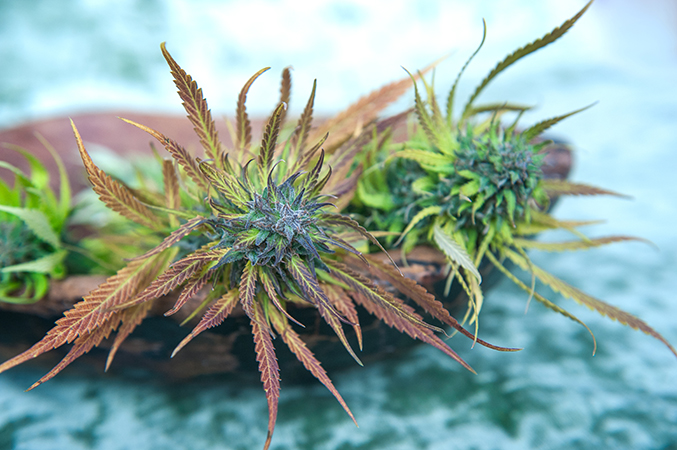
Sacred cannabis sativa flowers. Photo by Tracey Eller. Photo by Tracey Eller (ellerimages.com), courtesy @CosmicSister
Cannabis as Sacrament
Well-known Western yogis have generally adhered to the idea, at least in public, that cannabis is a maya, or illusion that separates us from the essence of reality. In India that propaganda never held for the most dedicated yogis, the sadhus.
World-renowned yoga teacher Nicki Doane of Maya Yoga in Maui has seen sadhus throughout India use cannabis for spiritual purposes.
“I can see the connection between the meditative state and using cannabis sacramentally,” she says. “I do believe it has the potential to open minds up—and that’s also what yoga does... I’ve witnessed yogis and sadhus in India smoking herb, and they seem like incredibly centered, peaceful people who definitely have a real spiritual practice. They didn't feel fake or contrived... These people are sitting in caves and smoking and meditating.”
Lexa Gillespie, a yoga teacher in Portland, Oregon, never realized the connection between cannabis and yoga until she found herself on a boat drifting along the Ganges River. Backlit by a dusty golden-pink sunrise, a shirtless, barefoot sadhu covered in cremation ash with “dreads that seemed to caress the Earth” approached carrying a brightly colored bag with a large red OM symbol on it.
“I was posed with the opportunity to ask this holy man, a man who has denounced his entire life in the name of yoga, any question my heart desired,” she says. She turned to the translator and asked him to ask the sadhu, "What does your daily sadhana [or spiritual practice] consist of?"
Without saying a word, the sadhu pulled a mala out of his bag, closed his eyes and began reciting a mantra. When the sadhu made his way around the entire mala, he put it away and returned his gaze to the boat passengers. A few moments later, the sadhu reached into his bag and pulled out a small clay chillum. Being a cannabis user herself, Gillespie was very aware of what was happening, but she was so surprised, she asked the translator to ask the sadhu what he was doing. A huge smile spread across the sadhu’s face.
"He said in a heavy accent, 'ganja,'—and despite the fact we were in the 'Ganga' River, I knew this was not what he was trying to say,” Gillespie says. “He repeated himself, then continued, to say: 'Ganja is moksha.' My heart smiled. After all of this time spent in self judgment about my cannabis use, here is this holy man who has denounced his life for a total spiritual pursuit, using cannabis to achieve ‘moksha,’ the sanskrit term for liberation.”
Breaking the Western Taboo
Aside from a vocal minority of teachers and others in the spiritual and wellness community, most well-known yoga teachers either avoid the topic of cannabis or rail against its use. Their reasoning usually calls on an important tenet of yogic philosophy: the necessity of a “pure body.” In general, Western yogis who avoid cannabis do so because they see it as an intoxicant in line with alcohol and harder drugs that alter reality or provide false enlightenment.
Dee Dussault, a yoga teacher who has offered “cannabis-enhanced” classes since the early 2000s, lets out a little laugh when asked whether cannabis use is maya. “The first thing I say to that is, then don’t do it,” she says. “Some people do yoga on a rubber sticky mat, and in India they might think that that’s weird—they do it on the bare floor. Some people do yoga to music, and some people would say that’s distracting and we’ve become reliant on the music, and the music is maya because it’s pulling us out of the reality of the moment, which is silence. Some people would be against taking caffeine before class. If you grab a coffee on the way to the yoga studio, you’ve enhanced your consciousness or altered your consciousness with coffee. Same with chocolate.”
Dassault’s ganja yoga classes are generally more restorative and back-to-basics in nature, and she recommends slower paced classes to students new to practicing with cannabis. She offers verbal suggestions designed to embody the poses and cultivate greater mindfulness. Her 2017 book Ganja Yoga, published by Harper Collins, breaks down her philosophy in detail.
Some people who come to her classes don’t want to use cannabis, but enjoy the slower, noncompetitive yoga. Because cannabis was legal only for those with medical recommendations for many years in California, her cannabis-enhanced classes were only open to medical marijuana users with a current recommendation. Students typically arrived half an hour before class begins and smoke or vape in casual communion. Now that California legalized the herb for adult use, anyone over 21 can come, as long as they purchase and consume their own cannabis.
When Dussault started offering ganja-yoga classes, she had no idea about cannabis and yoga’s shared history. In l 2012, when she briefly dated Chris Bennett, cannabis historian and author of Cannabis and the Soma Solution, she learned she’d tapped into something ancient. “It felt good to have this practice I was doing historically authenticated,” she says. “Like, ‘Oh, we’re just tapping into something super ancient?’ Of course, it’s a modern twist. I love that I just came to it of my own volition, or intuition. I didn't hear about it intellectually and then make the practice. The practice came first.”
April M. Short is a long time journalist focused on social justice, cannabis, psychedelics, yoga and health. She was awarded a Cosmic Sisters of Cannabis grant for journalistic writing work related to cannabis and women’s empowerment in early 2016. Disclosure: The Cosmic Sisters of Cannabis grant does not dictate or influence the author’s editorial choices, though portions of the grant were used to fund this article.
